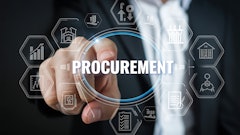Ineffective invoice reconciliation and payment systems hampering effective spend management, Aberdeen says
Boston — July 12, 2006 — On average, enterprises spend nearly half of every dollar they earn on external goods and services, but 69 percent of enterprises have limited or no visibility into critical financial information relating to the costs for these external goods and services, according to a new report from technology consultancy AberdeenGroup.
In its new survey-based study, "The Invoice Reconciliation and Payment (IR&P) Benchmark Report," Aberdeen found that three pressures cited by survey respondents are linked directly to visibility: reduction of cycle times to post expenses; more timely recognition of costs; and impact of rising supplier costs.
"One of the challenges in gaining visibility into costs is the large volume of paper-based transactions and variety in the types of billing processed," says Joe Basili, an Aberdeen research director and lead author of the report. "The data from processing bills should be integrated with sourcing, procurement and [enterprise resource planning (ERP)] systems to provide visibility into costs and maintain competitive position."
The report examines the implications of labor intensive manual processes. Basili offers specific recommendations for improving management of IR&P processes, which include:
The report is available at www.aberdeen.com/link/source.asp?cid=3185&pid=PRIR071006
Additional Articles of Interest
— Diversified, growing companies frequently confront the challenge of creating a unified customer experience, particularly around how they bill their clients. Office Depot took on this challenge by taking its accounts receivable processes online. Read more in "When A/R Stands for Competitive Advantage," a Best Practices case study in the June/July 2005 issue of Supply & Demand Chain Executive.
— Electronic invoice presentment and payment failed to meet its initial predictions. However, recent studies have uncovered a renaissance of interest in Web Invoicing & Electronic Payments solutions as organizations shift their emphasis toward cost containment and productivity enhancement. Read more in "The Analyst Corner: Payment," in the October/November 2005 issue of Supply and Demand Chain Executive.
Boston — July 12, 2006 — On average, enterprises spend nearly half of every dollar they earn on external goods and services, but 69 percent of enterprises have limited or no visibility into critical financial information relating to the costs for these external goods and services, according to a new report from technology consultancy AberdeenGroup.
In its new survey-based study, "The Invoice Reconciliation and Payment (IR&P) Benchmark Report," Aberdeen found that three pressures cited by survey respondents are linked directly to visibility: reduction of cycle times to post expenses; more timely recognition of costs; and impact of rising supplier costs.
"One of the challenges in gaining visibility into costs is the large volume of paper-based transactions and variety in the types of billing processed," says Joe Basili, an Aberdeen research director and lead author of the report. "The data from processing bills should be integrated with sourcing, procurement and [enterprise resource planning (ERP)] systems to provide visibility into costs and maintain competitive position."
The report examines the implications of labor intensive manual processes. Basili offers specific recommendations for improving management of IR&P processes, which include:
- Determine which manual steps cause the biggest delays and cost the most money.
- Automate labor-intensive invoice processing by adopting optical character recognition (OCR) scanning and increasing the use of HTML and electronic transactions.
- Identify top obstacles to capturing cash discounts and an alert system of escalations.
- Review your IR&P technology and compare the costs of integrating multiple systems with evaluations of newer integrated approaches.
- Create benchmarks to measure improvements for the costs of processing bills, time to process an invoice, audit findings, and volume of transactions.
The report is available at www.aberdeen.com/link/source.asp?cid=3185&pid=PRIR071006
Additional Articles of Interest
— Diversified, growing companies frequently confront the challenge of creating a unified customer experience, particularly around how they bill their clients. Office Depot took on this challenge by taking its accounts receivable processes online. Read more in "When A/R Stands for Competitive Advantage," a Best Practices case study in the June/July 2005 issue of Supply & Demand Chain Executive.
— Electronic invoice presentment and payment failed to meet its initial predictions. However, recent studies have uncovered a renaissance of interest in Web Invoicing & Electronic Payments solutions as organizations shift their emphasis toward cost containment and productivity enhancement. Read more in "The Analyst Corner: Payment," in the October/November 2005 issue of Supply and Demand Chain Executive.
- More research from AberdeenGroup.












![Pros To Know 2026 [color]](https://img.sdcexec.com/mindful/acbm/workspaces/default/uploads/2025/08/prostoknow-2026-color.mduFvhpgMk.png?ar=16%3A9&auto=format%2Ccompress&bg=fff&fill-color=fff&fit=fill&h=135&q=70&w=240)
